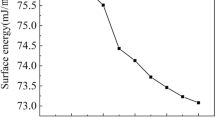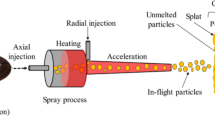Abstract
The effects of multiple ultrasonic impact treatments (UITs) on the surface properties of aluminum 6061 (Al 6061) were investigated, based on surface topography, hardness, and erosion. With one UIT pass, the value of the surface roughness decreased from 0.65 to 0.19 μm, after which it stabilized. Successive UIT passes caused the surface hardness to increase until it became saturated at 128 HV; this occurred after three UIT passes. X-ray diffraction results showed that as the number of UIT passes increased, the diffraction peak intensity decreased significantly and the full width at half maximum value increased. Debris accumulation was observed with successive UIT passes, which indicated that material was removed from the surface or the surface eroded. Multiple UITs did not cause significant damage to the top surface. It is considered that two principal mechanisms were involved in the evolution of the surface morphology over multiple UITs: plastic deformation and surface erosion by continuous strikes.
Similar content being viewed by others
References
Rubio-González C, Ocana J, Gomez-Rosas G, Molpeceres C, Paredes M, Banderas A, Porro J, Morales M (2004) Effect of laser shock processing on fatigue crack growth and fracture toughness of 6061-T6 aluminum alloy. Mater Sci Eng A 386(1):291–295. https://doi.org/10.1016/j.msea.2004.07.025
Zhang Y, Lu J, Ren X, Yao H, Yao H (2009) Effect of laser shock processing on the mechanical properties and fatigue lives of the turbojet engine blades manufactured by LY2 aluminum alloy. Mater Des 30(5):1697–1703. https://doi.org/10.1016/j.matdes.2008.07.017
Lu J, Luo K, Zhang Y, Cui C, Sun G, Zhou J, Zhang L, You J, Chen K, Zhong J (2010) Grain refinement of LY2 aluminum alloy induced by ultra-high plastic strain during multiple laser shock processing impacts. Acta Mater 58(11):3984–3994. https://doi.org/10.1016/j.actamat.2010.03.026
Trdan U, Grum J (2014) SEM/EDS characterization of laser shock peening effect on localized corrosion of Al alloy in a near natural chloride environment. Corros Sci 82:328–338. https://doi.org/10.1016/j.corsci.2014.01.032
Amanov A, Sasaki S, Kim DE, Penkov OV, Pyun YS (2013) Improvement of the tribological properties of Al6061–T6 alloy under dry sliding conditions. Tribol Int 64:24–32. https://doi.org/10.1016/j.triboint.2013.02.034
Grinspan AS, Gnanamoorthy R (2006) Surface modification by oil jet peening in Al alloys, AA6063-T6 and AA6061-T4: part 2: surface morphology, erosion, and mass loss. Appl Surf Sci 253(2):997–1005. https://doi.org/10.1016/j.apsusc.2005.12.164
Lu L, Sun J, Li L, Xiong Q (2016) Study on surface characteristics of 7050-T7451 aluminum alloy by ultrasonic surface rolling process. Int J Adv Manuf Technol 1–7
Wu X, Tao N, Hong Y, Xu B, Lu J, Lu K (2002) Microstructure and evolution of mechanically-induced ultrafine grain in surface layer of AL-alloy subjected to USSP. Acta Mater 50(8):2075–2084. https://doi.org/10.1016/S1359-6454(02)00051-4
Cho I-S, Amanov A, Kwak D-H, Jeong B-J, Park I-G (2015) The influence of surface modification techniques on fretting wear of Al–Si alloy prepared by gravity die casting. Mater Des 65:401–409. https://doi.org/10.1016/j.matdes.2014.09.036
Mordyuk B, Prokopenko G, Milman YV, Iefimov M, Sameljuk A (2013) Enhanced fatigue durability of Al–6Mg alloy by applying ultrasonic impact peening: effects of surface hardening and reinforcement with AlCuFe quasicrystalline particles. Mater Sci Eng A 563:138–146
Wen L, Wang Y, Zhou Y, Guo L, Ouyang J-H (2011) Microstructure and corrosion resistance of modified 2024 Al alloy using surface mechanical attrition treatment combined with microarc oxidation process. Corros Sci 53(1):473–480
Minglong C, Deyuan Z, Huawei C, Wei Q, Jinsheng L (2016) Surface nanocrystallization and its effect on fatigue performance of high-strength materials treated by ultrasonic rolling process. Int J Adv Manuf Technol 83(1–4):123–131
Azhari A, Schindler C, Godard C, Gibmeier J, Kerscher E (2015) Effect of multiple passes treatment in waterjet peening on fatigue performance. Appl Surf Sci
Arifvianto B, Mahardika M, Dewo P, Iswanto P, Salim U (2011) Effect of surface mechanical attrition treatment (SMAT) on microhardness, surface roughness and wettability of AISI 316L. Mater Chem Phys 125(3):418–426
Sharp PK, Clark G (2001) The effect of peening on the fatigue life of 7050 aluminium alloy
Feng Y, Hu S, Wang D, Cui L (2016) Formation of short crack and its effect on fatigue properties of ultrasonic peening treatment S355 steel. Mater Des 89:507–515. https://doi.org/10.1016/j.matdes.2015.10.009
Walter R, Kannan MB (2011) Influence of surface roughness on the corrosion behaviour of magnesium alloy. Mater Des 32(4):2350–2354. https://doi.org/10.1016/j.matdes.2010.12.016
Itoga H, Tokaji K, Nakajima M, Ko H-N (2003) Effect of surface roughness on step-wise S–N characteristics in high strength steel. Int J Fatigue 25(5):379–385. https://doi.org/10.1016/S0142-1123(02)00166-4
Liu Y, Li H, Li M (2015) Characterization of surface layer in TC17 alloy treated by air blast shot peening. Mater Des 65:120–126. https://doi.org/10.1016/j.matdes.2014.09.019
Li L, Kim M, Lee S, Bae M, Lee D (2016) Influence of multiple ultrasonic impact treatments on surface roughness and wear performance of SUS301 steel. Surf Coat Technol 307:517–524
Li L, Kim M, Lee S, Kim T, Lee J, Lee D (2017) A two-step periodic micro-nano patterning process via ultrasonic impact treatment on a rough SUS301 stainless steel surface. Surf Coat Technol
Arifvianto B, Mahardika M (2012) Effects of surface mechanical attrition treatment (SMAT) on a rough surface of AISI 316L stainless steel. Appl Surf Sci 258(10):4538–4543. https://doi.org/10.1016/j.apsusc.2012.01.021
Farhat Z, Ding Y, Northwood D, Alpas A (1996) Effect of grain size on friction and wear of nanocrystalline aluminum. Mater Sci Eng A 206(2):302–313. https://doi.org/10.1016/0921-5093(95)10016-4
Sanchez-Bajo F, Ortiz A, Cumbrera F (2006) Novel analytical model for the determination of grain size distributions in nanocrystalline materials with low lattice microstrains by X-ray diffractometry. Acta Mater 54(1):1–10
Mordyuk B, Prokopenko G (2006) Fatigue life improvement of α-titanium by novel ultrasonically assisted technique. Mater Sci Eng A 437(2):396–405. https://doi.org/10.1016/j.msea.2006.07.119
Sánchez-Bajo F, Ortiz AL, Cumbrera FL (2006) Analytical formulation of the variance method of line-broadening analysis for Voigtian X-ray diffraction peaks. J Appl Crystallogr 39(4):598–600. https://doi.org/10.1107/S0021889806017122
Wu B, Zhang J, Zhang L, Pyoun Y-S, Murakami R-I (2014) Effect of ultrasonic nanocrystal surface modification on surface and fatigue properties of quenching and tempering S45C steel. Appl Surf Sci 321:318–330. https://doi.org/10.1016/j.apsusc.2014.09.068
Dalla Torre F, Lapovok R, Sandlin J, Thomson P, Davies C, Pereloma E (2004) Microstructures and properties of copper processed by equal channel angular extrusion for 1–16 passes. Acta Mater 52(16):4819–4832. https://doi.org/10.1016/j.actamat.2004.06.040
Funding
This work was supported by “Development of Core Technologies for High-Reliability Vertical Machining Centers” of the Ministry of Trade, Industry and Energy (MOTIE), Korea (Grant No. 10063361), and “Development of Nano-level Surface Reformation Process and an Equipment using Ultrasonic Vibration” of the Ministry of Trade, Industry and Energy (MOTIE), Korea (Grant No. 10047618).
Author information
Authors and Affiliations
Corresponding author
Rights and permissions
About this article
Cite this article
Li, L., Kim, M., Lee, S. et al. Study on surface modification of aluminum 6061 by multiple ultrasonic impact treatments. Int J Adv Manuf Technol 96, 1255–1264 (2018). https://doi.org/10.1007/s00170-018-1666-x
Received:
Accepted:
Published:
Issue Date:
DOI: https://doi.org/10.1007/s00170-018-1666-x




